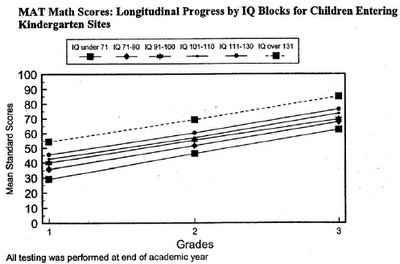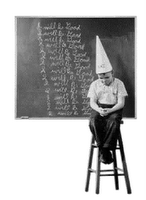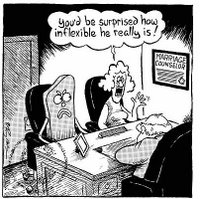 (This is part five of a multi-part series on your baiin and why constructivism doesn't work. Start at part one.)
(This is part five of a multi-part series on your baiin and why constructivism doesn't work. Start at part one.)In
part four, we learned how knowing a lot of stuff helps you learn, think about, and retain new information and skills. In this installment we'll learn why learning by solving problems, the main theory behind most of constructivism, frequently makes learning more difficult.
The theory underlying constructivism is that people learn best in an unguided or minimimally guided environment , generally defined as one in which students, rather than being persented with essential information, must discover or construct essential information for themeselves. Thus, constructivism requires the novice student to search a problem space for problem-relevant information to discover the essential information,
i.e., the solution to the problem posed.
As we learned in previous installments, this search must occur in our limited working memory (WM). All problem-based searching makes heavy demands on WM and often overburdens the limited WM, requiring WM resources be used for activities that are unrelated to learning. Therefore, while your brain's WM is consumed searching for a problem solution, it's not contributing to the accumulation of knowledge in long-term memory (LTM). As a consequence, students can engage in problem-solving activities for extended periods and learn almost nothing (
i.e., store what's been learned in LTM).
Bear in mind, the goal of instruction is rarely just to search for or discover information. The goal of education is to give learners specific guidance about how to cognitively manipulate information in ways that are consistent with a learning goal,
and store the result in LTM.
Allegedly, constructivism helps students to derive meaning from learning materials. However, cognitive load theory suggests that the free exploration of a highly complex environment generates a heavy WM load that is detrimental to learning. This suggestion is particularly important in the case of novice learners who lack proper cogntive LTM structures to integrate the new information with their prior knowledge.
The consequences of requiring novice students to search for problem solutions using a limited WM or the mechanisms by which unguided or minimally guided instruction might facilitate change in LTM appear to be routinely ignored in constructivist theory. The result is a set of differently named but similar instructional approaches requiring minimal guidance that are disconnected from much that we know of human cognition.
Novice students learn much more from examining worked problem examples rather than solving the problems themselves. This effect only disappears and reverses as the student's expertise increases. Problem solving only becomes relatively effective when learners are sufficiently experienced so that studying a worked example is, for them, a redundant activity that increases WM load compared to generating a known solution. This phenomenon emphasizes the importance of providing novices in an area with extensive guidance because they do not have sufficient knowledge in LTM to prevent unproductive problem-solving search.
That guidance can be relaxed only with increased expertise as knowledge in LTM can take over from external guidance. The vast majority of students at the K-12 level are novices in the subjects they are learning who do not have the needed expertise.
Because novice students learn so little from the constructivist approach, most teachers who attempt to implement classroom-based constructivist instruction end up providing students with considerable guidance or direct instruction. In fact, teachers frequently provide a lot of “scaffolding” when students fail to make learning progress in a discovery setting. If they expect to be effective, teachers typically spend a great deal of time in instructional interactions with students by:
simultaneously teaching content and scaffolding-relevant procedures … by (a) modeling procedures for identifying and self-checking important information…(b) showing students how to reduce that information to paraphrases … (c) having students use notes to construct collaborations and routines, and (d) promoting collaborative dialogue within problems.
One of the more frequent excuses for retaining the inquiry or problem solving instructional theme, even when it is heavily scaffolded with direct instruction and guidance, is the belief that providing students with partial information enhances their ability to construct an LTM representation more than giving them full information. This is incorrect.
Most students of all ages know how to construct knowledge when given adequate information and there is no evidence that presenting them with partial information is beneficial. Actually, the resevesr seems most often to be true. Students must construct a mental representation or schema in LTM regardless of whether they are given partial or complete information. Complete information will result in a more accurate representation that is also more easily acquired.
And, while there is little doubt that students remember material they generate themselves better than material that is handed to them. This "generation effect," as it is called, is indeed powerful, and it is due, in part, to forcing the learner to think about the meaning of material (although other techniques can do that as well). Part of the effect does seem to be unique to the actual generation of the answer, over and above thinking about meaning. For this reason constructivists believe that discovery learning should be employed whenever possible. However, given that memory follows thought, one thing is clear:
Students will remember incorrect "discoveries" just as well as correct ones.
Altering LTM is the ultimate goal of learning. The generation effect does affect how information is learned, but so do many other factors that we've discussed in previous installments. The main underlying flaw of constructvism is the undue attention paid to the generation effect to the detriment of recognizing the important limitations of our working memory. Moreover, it ignores the very real negative byproducts when students acquire misconceptions or incomplete or disorganized knowledge. Today, there is little evidence that supports the notion that learning under a constructivist pedagogy is as good as, much less improved, over well designed direct instruction at the K-12 level.
This brings us to the point where we can finally discuss the remaining underlying fallacies of constructivism. We'll do that in the next installment.













